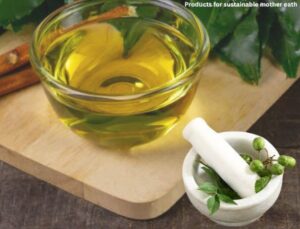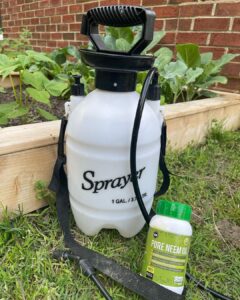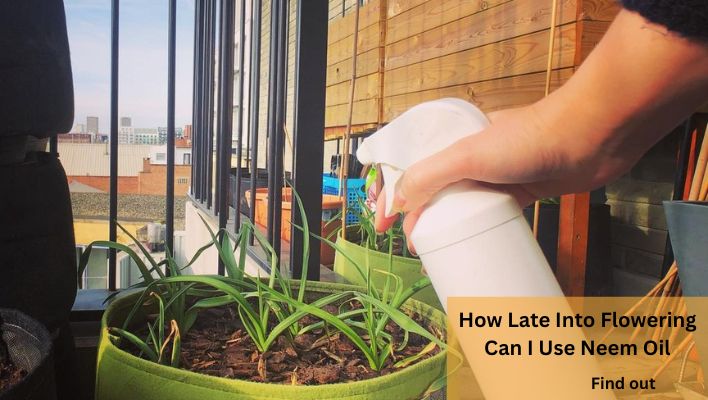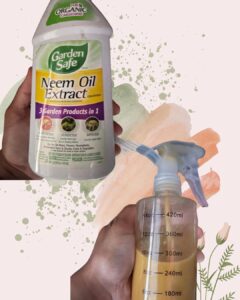Neem oil is a natural, plant-based oil used for centuries in traditional medicine and agriculture. It is derived from the seeds of the neem tree, native to India and Southeast Asia. It is known for its antibacterial, antifungal, and insecticidal properties, making it a popular choice for gardeners looking for a natural solution to pest and disease problems.
In gardening, neem oil is a valuable tool for controlling many pests, including aphids, mealybugs, mites, and whiteflies. It can also be effective against fungal diseases such as powdery mildew and black spot. However, many gardeners are unsure of how late into flowering they can use neem oil without harming their plants.
We’ve put together this article to answer the question: How late into flowering can I use neem oil? We’ll explore the benefits and uses of neem oil in gardening and provide some tips and guidelines for using it safely and effectively in your garden.
Whether you’re a seasoned gardener or just starting out, this article will help you make the most of neem oil and keep your plants healthy and thriving.
Understanding Neem Oil
Neem oil is a natural extract derived from the seeds of the neem tree, which is native to India. The oil is extracted using cold-pressed methods, ensuring it retains its natural properties.
The active ingredients in neem oil are compounds called azadirachtin, Nimbin, and galanin. These compounds have been shown to have antibacterial, antifungal, and antiviral properties.

When applied to plants or used on the skin, neem oil disrupts the life cycle of insects and pests, preventing them from reproducing and causing damage. It also has anti-inflammatory properties that can help to soothe irritated skin and reduce inflammation.
Neem oil is a safe and effective alternative to chemical pesticides and can be used in various applications, from gardening to personal care. It is a versatile and sustainable resource used for centuries in traditional medicine and agriculture.
Understanding Flowering Stage
The flowering stage refers to the period in a plant’s life cycle when it begins to produce flowers. This stage is crucial as it signals the transition from vegetative to reproductive growth.
This is when the plant begins to produce flowers, which eventually leads to the development of fruits or seeds. The plant requires the most attention and care to ensure a successful harvest during this stage.
Understanding the flowering stage is essential for gardeners and farmers alike as it can greatly impact the yield and quality of the crop.
There are different stages of flowering, each with its characteristics. The pre-flowering step is when the plant begins to show signs of bud formation. The early flowering stage is when the buds start to open up and reveal their petals.
The mid-flowering stage is when the flowers are fully open and are at their peak. The flowers begin to fade and wither away in the late flowering stage.
Timing is critical when using neem oil during the flowering stage. So, using neem oil during the wrong plant life cycle stage can lead to negative consequences such as stunted growth or reduced yields.
Therefore, it is essential to apply neem oil during the early flowering stage, preferably before the buds begin to form. This will help to prevent pests and diseases from attacking the plant while minimizing the risk of damaging the flowers or the fruit.
Tips for Using Neem oil during Flowering Stage
Gardeners and farmers can ensure a successful and bountiful harvest by understanding the different flowering stages and the importance of timing in using neem oil.
If you want to use neem oil in your garden during the flowering stage, you can do so safely up to a certain point. Generally, it is safe to use neem oil up until the third or fourth week of the flowering stage.
After this point, it is best to avoid using neem oil as it may affect the taste and aroma of your plants. Additionally, neem oil may also interfere with the pollination process, which can reduce your yield.
It is important to do so cautiously if you need to use neem oil during the flowering stage. Here are some tips to keep in mind:
- Use a low concentration of neem oil: When applying neem oil to flowering plants, it is important to use a lower concentration than you would during the vegetative stage. This will help to reduce the risk of damaging the flowers or altering their taste and aroma.
- Apply in the early morning or late evening: Neem oil should be applied during the coolest part of the day, either early in the morning or late in the evening. This will help to minimize the risk of sunburn and reduce the impact of the oil’s odor and taste.
- Avoid spraying directly on flowers: When applying neem oil during the flowering stage, it is important to avoid spraying it directly on the flowers themselves. Instead, focus on the leaves and stems of the plant, where pests are most likely to be found.
- Test on a small area first: If you are unsure how your plants will react to neem oil during the flowering stage, it is a good idea to test it on a small area first. This will help you gauge the plant’s response and avoid potential damage.
While it is generally best to use neem oil during the vegetative stage of plant growth, it is possible to use it during the flowering stage if necessary. However, it is important to use caution and follow the tips outlined above to avoid damaging the plants or altering the taste and aroma of the flowers.
Is neem oil safe on buds?
Yes, neem oil is generally safe to use on buds during the flowering stage of plants. However, it is important to use neem oil in moderation and follow the manufacturer’s instructions carefully to avoid any negative effects on the quality of the final product.
Overuse of neem oil on buds can result in a bitter taste and unpleasant odor in the finished product, so avoiding using neem oil during the final weeks before harvest is best. Additionally, it is recommended to test neem oil on a small plant area first to ensure no adverse reactions.
When should you not use neem oil on plants?
While neem oil is a natural and effective solution for controlling pests and diseases in plants, there are certain situations where it should not be used. Here are some examples:
- High temperatures: Avoid using neem oil on plants during extreme heat, as this can cause the oil to burn and damage the plant leaves.
- On young or newly transplanted plants: Neem oil can be too strong for young or delicate plants and may cause damage or stunted growth.
- Direct sunlight: It is not recommended to apply neem oil to plants during direct sunlight, as it can cause sunburn on the leaves.
- On stressed plants: Stressed plants, such as those suffering from drought or nutrient deficiencies, may not respond well to neem oil treatment and may become further weakened.
- Near water sources: Avoid using neem oil near water sources, such as ponds or streams, as it can be toxic to aquatic life.
- Late flowering: Using neem oil during the final weeks of flowering can affect the flavor and aroma of the final product. It is best to avoid using neem oil during this stage to ensure the quality of the harvest.
- Allergies: Some individuals may be allergic to neem oil, so it is important to test a small area of the plant first and wear protective clothing and equipment when applying neem oil.
There is no doubt that neem oil is an effective and natural solution for controlling pests and diseases in plants. Still, it is important to use it responsibly and avoid it in certain situations where it may cause harm or negatively affect the final product.
Benefits of Using Neem Oil
Using neem oil during the flowering stage of a plant can have several benefits. Here are some of the benefits of using neem oil during the flowering stage:
Advantages
- Pest Control: Neem oil is a natural pesticide that can help control pests such as spider mites, whiteflies, and aphids. These pests can damage the plants during the flowering stage, and neem oil can help prevent this damage.
- Fungal Control: Neem oil also has antifungal properties that can help prevent and control fungal diseases such as powdery mildew and black spot. These diseases can also affect the plant during the flowering stage and cause damage to the flowers.
- Stimulates Growth: Neem oil contains natural growth stimulants that can help promote healthy growth during the flowering stage. It can also help improve the plant’s nutrient uptake and photosynthesis, leading to bigger and healthier flowers.
- Boosts Immune System: Neem oil has immune-boosting properties that can help the plant fight diseases and pests. This can help the plant stay healthy during the flowering stage and produce better flowers.
Neem oil is a great natural solution for maintaining healthy and thriving plants during flowering. It is safe, organic, and effective, making it an ideal choice for gardeners and farmers.

Disadvantages:
- Unpleasant Smell: Neem oil has a strong and unpleasant smell that can linger on plants.
- Stains: Neem oil can stain clothing, skin, and other surfaces, so it should be handled carefully.
- Late Application: If neem oil is applied too late into the flowering stage, it can affect the taste and aroma of the final product.
Risks and potential adverse effects of using neem oil too late into the flowering stage:
- Affects Taste and Aroma: If neem oil is applied too late into the flowering stage, it can affect the taste and aroma of the final product.
- Residues: Neem oil residues can remain on the flowers even after harvest, affecting the final product’s quality and safety.
- Toxicity: If ingested, neem oil can be toxic to humans and pets, so it should be used cautiously.
Therefore, using neem oil early in the flowering stage is recommended to reap its benefits and avoid any risks associated with using it too late. Using neem oil during the flowering stage can be highly beneficial, but using it in moderation and with caution is vital to avoid any adverse effects.
Conclusion
No iota of doubt neem oil is an effective and natural insecticide and fungicide that can be used throughout the growing season to control pests and diseases in plants. However, when using neem oil late into flowering, it is important to exercise caution and follow the manufacturer’s instructions carefully.
Neem oil can potentially impact the flavor and aroma of the final product if used too late into flowering, and excessive use may also result in the accumulation of residues on the plant. Therefore, it is advisable to use neem oil early in the flowering stage and avoid using it during the final weeks before harvest.
By using neem oil responsibly, growers can protect their plants from pests and diseases without compromising the quality of their final harvest.

